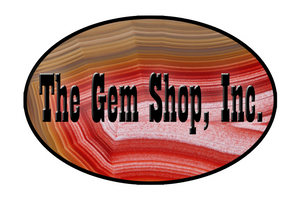History of Mushroom Rholite
Mushroom Rhyolite, sometimes called "Mushroom Jasper," is found in several areas northwest of Phoenix, Arizona. This rhyolite gets its name from the repeating grey egg pattern that sometimes looks like a mass of growing mushrooms. The formation is congruent to that of a thunderegg however it is atypical due to how most of the thundereggs are incomplete in their formation. The thunderegg started to form, stopped, and started again, forming the gray overlapping shapes in the rhyolite. In certain areas a reddish halo surrounds the outside of the grey, massive thundereggs providing a colorful contrast on the rock. Outside the reddish halo, the host rock can be a greenish color and when it is hard enough, it provides a grey, red, and green color combination that can be very attractive.
The deposit of Mushroom Rhyolite mined in 2011 was explored and developed by friend of The Gem Shop's founder, Eugene Mueller: Darrel "Jake" Jacobitz. Jacobitz dug the area by hand for several years and posted a claim marker, calling the area the Sherrie Ann claim. He planned to mine it with machinery but these plans were put to an end after medical complications arose. Jacobitz asked Mueller if her would buy the claim, thus bringing the claim under the ownership of The Gem Shop, Inc.
Mueller rented a 320 Excavator from Caterpillar for one week in October 2011 and had it moved close to the claim on November 2nd. Jose Luis Villegas, Mueller's partner in their Mexican company, Agata Exploraciones SA de CV, was with Mueller to experience the operation. Dale Ott, who dug in this claim with Jacobitz, was there to give the two miners advice and encouragement. Mr. Ott has a property about 30 miles away and offered it as a place to store the rock extracted from this expedition.
The deposit is composed of perlite and rhyolite layers exposed on end, up a gentle eastern slope of a ridge running north to south. The rhyolite layers contain massive clumps and sausage-shaped groups, as well as individual thundereggs of all sizes. Many of these layers have been dug by hand and it was easy to see where they were in the ground.
The claim is about one and a half miles south of the nearest road so it did not take to long to "walk" the excavator to the mining site after the Caterpillar truck dropped it off. Mueller had arrived the day before with his trailer and set up a small camp so he and Villegas were ready to start soon after Mueller drove the machine to the mine.
The two miners started digging on the southern end of the claim on one of the lower layers of the exposed rhyolite. This area had been dug by hand earlier and, according to Mr. Ott, had produced some of the best material sporting the aforementioned "red halos." It was not long before they were creating piles of rock to haul back to camp. For the next couple of days, Mueller followed the rhyolite between the layers of black perlite and then moved the excavator up the ridge to the next exposed layer of rhyolite. Mr. Ott told Mueller and Villegas that the green material was a little thicker and better on the top of the ridge, so Mueller worked the top of the ridge towards the end of the week. One disappointing aspect of the exploratory mining operation was the lack of depth Mueller was capable of digging with the excavator. To get material deeper underground, it will be necessary to rent a hydraulic ram or use controlled explosives. The massive thundereggs are fairly dense in their individual layers and the miners were able to produce over 5 tons of rock in one week. They hauled some of the rock to Mr. Ott's place, then put the rest in Mueller's and Villegas' vehicles, promptly leaving for the Tucson Showplace in Tucson, AZ.
